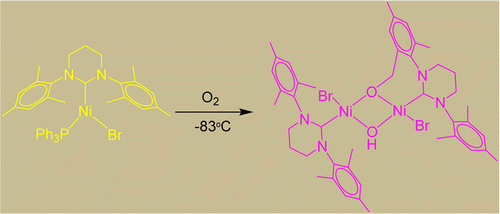Activation of O2 by the three-coordinate Ni(I) ring-expanded N-heterocyclic carbene complexes Ni(RE-NHC)(PPh3)Br (RE-NHC = 6-Mes, 1; 7-Mes, 2) produced the structurally characterized dimeric Ni(II) complexes Ni(6-Mes)(Br)(μ-OH)(μ-O-6-Mes′)NiBr (3) and Ni(7-Mes)(Br)(μ-OH)(μ-O-7-Mes′)NiBr (4) containing oxidized ortho-mesityl groups from one of the carbene ligands. NMR and mass spectrometry provided evidence for further oxidation in solution to afford bis-μ-aryloxy compounds; the 6-Mes derivative was isolated, and its structure was verified. Low-temperature UV–visible spectroscopy showed that the reaction between 1 and O2 was too fast even at ca. −80 °C to yield any observable intermediates and also supported the formation of more than one oxidation product. Addition of O2 to Ni(I) precursors containing a less electron-donating diamidocarbene (6-MesDAC, 7) or less bulky 6- or 7-membered ring diaminocarbene ligands (6- or 7-o-Tol; 8 and 9) proceeded quite differently, affording phosphine and carbene oxidation products (Ni(O═PPh3)2Br2 and (6-MesDAC)═O) and the mononuclear Ni(II) dibromide complexes (Ni(6-o-Tol)(PPh3)Br2 (10) and (Ni(7-o-Tol)(PPh3)Br2 (11)) respectively. Electrochemical measurements on the five Ni(I) precursors show significantly higher redox potentials for 1 and 2, the complexes that undergo oxygen atom transfer from O2.
